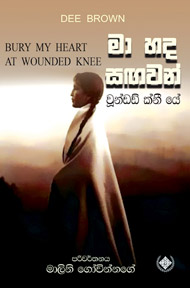|
Book review:
‘Bury My Heart’ in Sinhala
During the height of Vietnam War and the Civil Rights Movement in
America, an American librarian wrote a book. Being the first book
written from the perspective of the Indigenous people of America who
were known as Indians or Red Indians, it was a groundbreaking
publication in its time. It changed the world view about the Native
Americans who were mentioned as savages by American historians who
chronicled the American history.
By the time Dee Brown’s Bury my Heart at Wounded Knee came out in
1970, Native Americans who survived many genocides committed by the
Euro-Americans had been removed from their original habitats and were
confined to the land areas known as reservations.
 They had been denied their freedom of movement, their livelihood-
hunting, freedom to practice their ancient religion, freedom to
communicate in their own languages and freedom to bring up their
offspring within their tribal families. They had been denied their freedom of movement, their livelihood-
hunting, freedom to practice their ancient religion, freedom to
communicate in their own languages and freedom to bring up their
offspring within their tribal families.
In popular culture they were viewed as wicked and whooping warriors
and sometimes friendly farmers in Thanks Giving Day ceremonies .These
ceremonies were held by the European settlers to give thanks to God for
guiding them safely to the New World, which is America.
Dee Brown changed this view.
He uses a number of references to write the book. American Congress
council records, reports of the treaties signed between the US
government and the Native American tribes, records of the meetings of
the two parties before the treaty signing, autobiographies and firsthand
descriptions, reports in contemporary Journals which were obscure and
did not have much circulation, to document a history of a people who
were demoralized and defeated.
Brown’s focus is on the thirty year span of history between 1860 and
1890. Beginning with the removal of five Native American tribes at
gunpoint from their habitats to an arid and most inhospitable land area
near New Mexico, in 1864, ending thirty years later with the massacre of
350 Indian men women and children at Wounded Knee South Dacota, Brown
tells how the American Indians lost their land and culture to an
expanding white people.
When the book came among the American readers some 80 years after the
last massacre at Wounded Knee, many US citizens were already feeling
guilty about their government’s involvement in the Vietnam War. With his
book Brown focuses attention on another national disgrace- extermination
of the natives of the land. He depicts in detail, the US government’s
grabbing of Native Americans’ lands by using mix of threats, deception
and murder, its attempts to crush the indigenous culture.
The acts were justified by the theory of Manifest Destiny, which
stated that European settlers turned US citizens had a god-given right
to own the land and its wealth from the natives.
Each chapter tells the plight of a different Native American tribe in
a different region of the continent. But with each tribe in each region
the story is familiar; when valuable natural resources are discovered on
Native American land, the US government agents are sent out to negotiate
with the Indians for the rights of the land. They force the Indians to
sign a treaty that guarantees the Indians land and supplies in exchange
for their compliance.
When Americans discover more wealth in the new Indian land, the
Indians are forced often at gunpoint to sign a new treaty ceding their
new land to relocate to smaller land areas known as reservations.
Eventually the desperate and angry Indians attack the soldiers who have
been sent to enforce the treaties that the tribal chiefs have signed.
The US soldiers attack the Indian villages, burning houses, murdering
men women and children. Sometimes they would preserve the corpses of
notable Indians and exhibit them at carnivals and fairs.
At the end, the massacre at Wounded Knee breaks the Indians’ will to
retaliate anymore.
This epoch-making book is a scathing indictment of the US government,
its army and the American people at a particular period of American
history.
It fully documents the systematic destruction, the slow inexorable
holocaust of the indigenous American during the second half of the 19th
century. And it tells the story of what the US was built on.
Translated into almost every language of the West, now Bury My Heart
at Wounded Knee is available in Sinhala translation as a Wijesooriya
Grantha Kendraya publication titled Ma Hada Sangavan Wounded Knee ye.
|





